Mountains
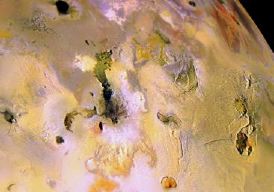 Not
all mountains on Io are volcanic in origin. About two
percent of the surface is occupied by mountains which have
formed by other processes, such as uplift and thrust
faulting. Some of these mountains rise to great heights,
such as Euboea Montes which is 13 km (8 miles) high. Their
sheer size and steepness provide further evidence that the
material underlying them is rock and not some form of
sulfur. Sulfur does not have the strength to support
mountains of this size. The lengths of the shadows cast by
the mountains allow scientists to estimate the their height.
The mountain in the far right of this image has been
determined to be approximately 8 km (5 miles) in
height.
Not
all mountains on Io are volcanic in origin. About two
percent of the surface is occupied by mountains which have
formed by other processes, such as uplift and thrust
faulting. Some of these mountains rise to great heights,
such as Euboea Montes which is 13 km (8 miles) high. Their
sheer size and steepness provide further evidence that the
material underlying them is rock and not some form of
sulfur. Sulfur does not have the strength to support
mountains of this size. The lengths of the shadows cast by
the mountains allow scientists to estimate the their height.
The mountain in the far right of this image has been
determined to be approximately 8 km (5 miles) in
height.
How these mountains form is not completely understood. One theory suggests that crustal recycling is a possible cause. Io is continually being resurfaced by volcanic activity at a rate of approximately 1 cm/year. At this rate, one kilometer of material is being added to the surface every 100,000 years. The weight of this material places tremendous strain on the crust, and may cause it to sink and merge with the molten mantle. As a result of this compression, large crustal blocks may be forced upward along deep faults. It is also possible that some of the mountains may have formed as a result of intrusions of magma from deep within Io's interior.
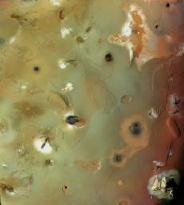 Images
of Euboea Montes (upper right) suggest that it formed from
the uplift of a large crustal block. Close examination of
images of the mountain reveal that uplift caused a landslide
which formed an enormous debris apron at its base. The size
of the debris flow is 200 km (125 miles) wide and contains
an estimated 25,000 cubic km of rock. This landslide is
10,000 times larger than the one that occurred during the
Mt. St. Helens eruption in 1980. Only on the flanks of
Olympus Mons on Mars have avalanches of this size been
observed.
Images
of Euboea Montes (upper right) suggest that it formed from
the uplift of a large crustal block. Close examination of
images of the mountain reveal that uplift caused a landslide
which formed an enormous debris apron at its base. The size
of the debris flow is 200 km (125 miles) wide and contains
an estimated 25,000 cubic km of rock. This landslide is
10,000 times larger than the one that occurred during the
Mt. St. Helens eruption in 1980. Only on the flanks of
Olympus Mons on Mars have avalanches of this size been
observed.
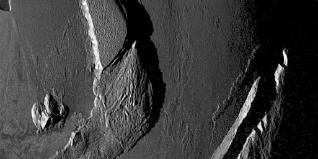 Avalanches
may also be responsible for the destruction of Ionian
mountains. This recent Galileo image shows a number of
ridges parallel to the margins of the mountains. This
provides evidence that huge landslides are being generated
as the force of gravity causes the mountains to collapse.
Avalanches
may also be responsible for the destruction of Ionian
mountains. This recent Galileo image shows a number of
ridges parallel to the margins of the mountains. This
provides evidence that huge landslides are being generated
as the force of gravity causes the mountains to collapse.
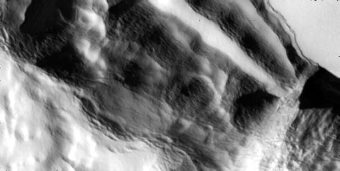 Telegonus
Mensa was imaged by the Galileo spacecraft in October, 2001
for the purpose of studying erosional processes on Io. This
image shows a cliff slumping on the edge of the mountain. On
Earth, wind and water are the primary agents of erosion.
Since Io has neither water nor an atmosphere to generate
winds, the slumping is due to the the force of gravity.
Telegonus
Mensa was imaged by the Galileo spacecraft in October, 2001
for the purpose of studying erosional processes on Io. This
image shows a cliff slumping on the edge of the mountain. On
Earth, wind and water are the primary agents of erosion.
Since Io has neither water nor an atmosphere to generate
winds, the slumping is due to the the force of gravity.
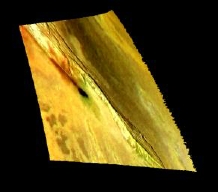 The
240 km (150 mile) long mountain in this colorized image
provides information about the various types of materials
that make up Io's mountains. The bright red material is
believed to be a compound of sulfur that forms at very high
temperatures. The likely source of heat is molten rock
material. The yellow areas are other types of sulfur
compounds, and black indicates fresh silicate lava. The
green material tends to form when sulfur lands on warm lava.
The image reveals that the red material has blown out of a
long crack on the western side of the mountain. Lava is seen
emerging along the fault, and it defines the side of the
mountain. Scientists speculate that rising plumes of hot
material may be instrumental in forming these mountains.
The
240 km (150 mile) long mountain in this colorized image
provides information about the various types of materials
that make up Io's mountains. The bright red material is
believed to be a compound of sulfur that forms at very high
temperatures. The likely source of heat is molten rock
material. The yellow areas are other types of sulfur
compounds, and black indicates fresh silicate lava. The
green material tends to form when sulfur lands on warm lava.
The image reveals that the red material has blown out of a
long crack on the western side of the mountain. Lava is seen
emerging along the fault, and it defines the side of the
mountain. Scientists speculate that rising plumes of hot
material may be instrumental in forming these mountains.
This
recent image may provide evidence of rifting on Io. In the
center of the picture is a dark depression called Hi'iaka
Patera. The northern and southern margins of Hi'iaka Patera
have remarkably similar shapes which indicates they may have
once fit together. Furthermore, the mountains to the north
and south look like they split and slid apart (by 145 km (90
miles), forming a basin similar to Death Valley in
California. Lateral movements such as this are caused by
plate tectonics on Earth, but no evidence of a similar
process on Io has yet been discovered. Scientists speculate
that deep mantle plumes of rising masses of hot rock may be
driving the movements.
Photo Credits: NASA/JPL
